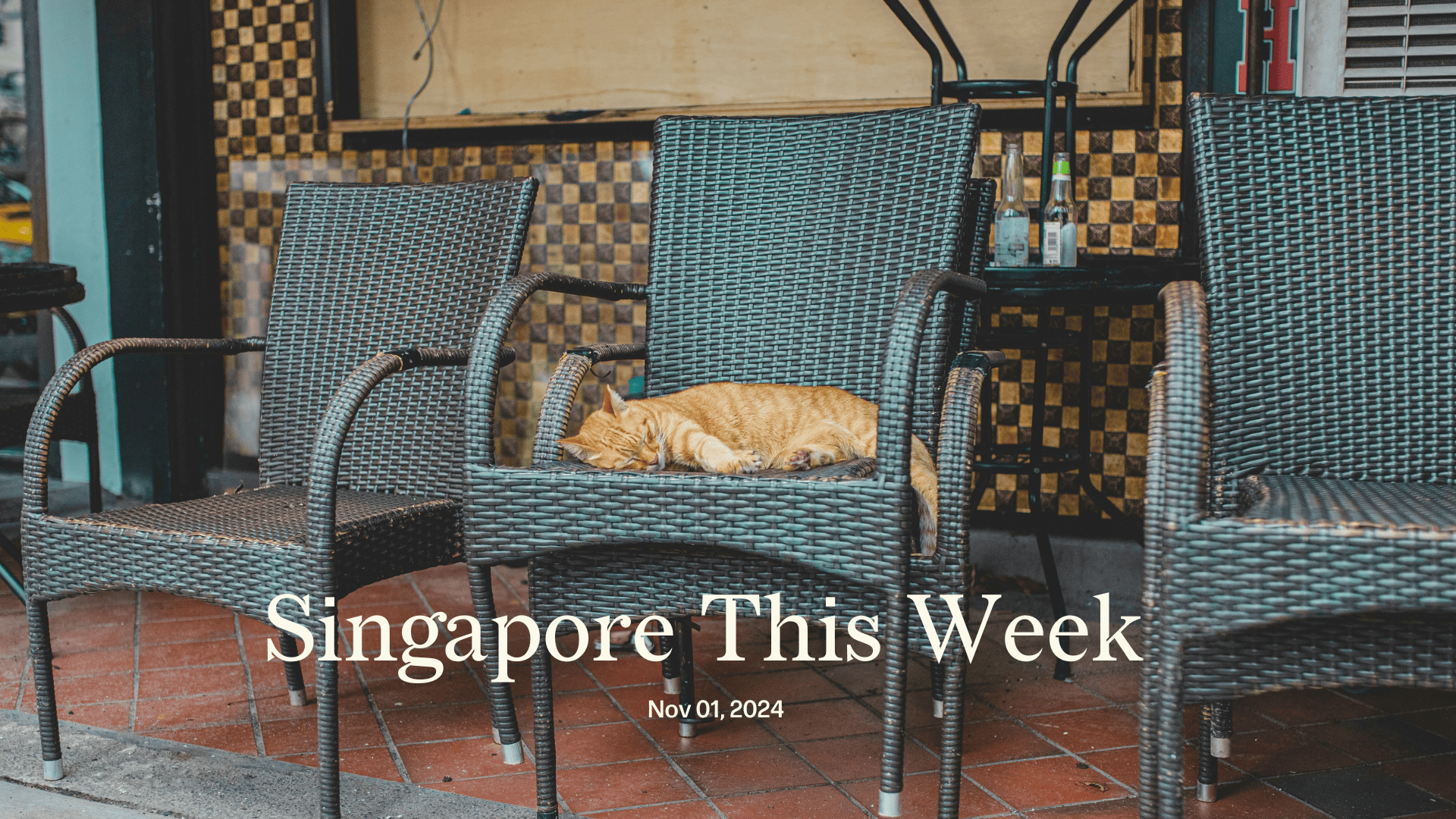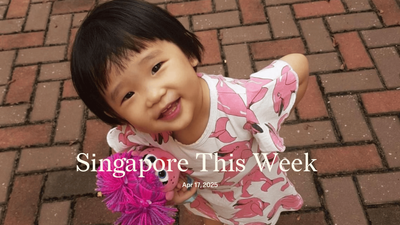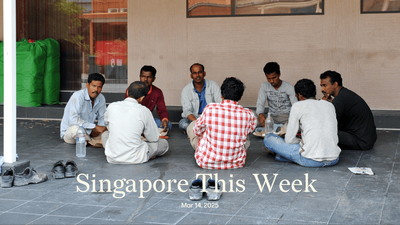Politics: Palestine
Attendees to Olivia Rodrigo’s recent concerts in Singapore had Palestinian insignia, like watermelon keychains, removed by security before they entered. Notwithstanding these bizarre instances of censorship, perhaps prompted by official efforts to quell public discourse on Gaza, Palestine-related support, organising, and resistance have been highlights of Singaporean civil society this past year. Consider, just to name a few, the huge sums of money raised for relief efforts in Gaza; the most urgent interrogation ever into Singapore’s relationship with Israel; the unfurling of an “End SG-Israel Arms Trade” banner in Gardens by the Bay; and a peaceful walk to the Istana that ended with three women charged.
This past week has seen two new efforts that you can get involved in. There’s a petition asking Singapore to recognise the State of Palestine. There’s also the Palestinian Scholarship Initiative, launched at Hush TeaBar last Saturday, that seeks to raise S$400,000 to support Palestinian students pursuing university education in Singapore. Partners for the ground-up, people-to-people initiative include Ray of Hope, a crowdfunding charity that’s also an Institution of a Public Character (IPC); the United Nations High Commissioner for Refugees (UNHCR); the Arab Network @ Singapore; and Opening Universities for Refugees. Its independent Scholarship Administration Committee is co-chaired by Yaacob Ibrahim, a former minister, and Anthea Ong, a former nominated Member of Parliament. In a week when Israel banned the UN relief and works agency (UNRWA), the largest provider of humanitarian aid to the country’s Palestinian population, our shared global responsibility towards this persecuted community has never felt greater. “You will know what to do,” Ang Swee Chai, humanitarian and doctor, had told Singaporeans on her last trip here. You can donate here.
Some further reading: “Genocide in Gaza? Our moral responsibility” by Jom’s team
Society: The people versus the preservationists
In a survey conducted in 2015 by YouGov, 77 percent of 1,000 Singaporeans surveyed said that they are in favour of demolishing the late Lee Kuan Yew’s old house at 38 Oxley Road (only 15 percent were opposed to it), as was his preference. This week, MustShareNews reported on a new poll by answers.sg of over 14,000 respondents, in which almost 65 percent supported demolition, with 26.3 percent opposed. Notwithstanding analytical differences between the two—answers.sg doesn’t appear to filter and verify respondents—this might suggest that Singaporeans are slowly coming round to the idea of preservation, though still clearly in favour of demolition.
In recent days, luminaries have lent their voice to the debate. “This basement dining room was also the meeting place of student radicals, trade unionists, women’s rights activists and budding politicians. This was where today’s Singapore was hatched. It must be preserved as it is, not an artificial duplicate…” said Tay Kheng Soon, pioneering architect. “Rebuild Oxley Road basement dining room at Founders’ Memorial”, meanwhile, was the headline for a letter to The Straits Times (ST) by Margaret Thomas, a veteran journalist.
The National Heritage Board (NHB) said it will commence a study to “assess if the site has national historical, heritage, and architectural significance as to be worthy of preservation.” (The somewhat byzantine process of studies and recommendations is captured in this ST explainer.) Finally, we know that leaders of the ruling People’s Action Party (PAP), two of whom were involved in the ministerial committee report that NHB is now referencing, wanted to preserve the house because of party political history. In Lee’s 2012 words, “…the cabinet has opposed tearing it down and rebuilding, because 2 PMs have lived in the house, me and [Lee Hsien] Loong…”
The only thing that seems clear at this stage is that Singaporean society still cannot extricate itself from the often suffocating embrace of the Lees. Shame.
Society: We love them, yet can be so cruel
Cats are having a rough time of it in Singapore. Abductions, abandonment, abuse, murder; humans can be a brutal bunch. Last month, Barrie Lin Pengli admitted to three counts of animal cruelty. Two similar charges will also be considered when he’s sentenced on November 13th. Five felines living outdoors bore the brunt of his sadistic acts—what prosecutors called “one of the worst cases of animal cruelty”—including two who were killed. Lin won’t be alone in getting his comeuppance. Ryan Tan Yi Bin was charged on October 7th under the Animals and Birds Act for allegedly kicking a community cat, stepping on its head and then throwing it from the 38th floor of an HDB flat to its death. Tan’s victim, “Field Field”, was a beloved fixture of the block, so much so that residents held a memorial at her favourite spot. The National Parks Board is also investigating the slashing of four community cats.
It’s a peculiar and dysfunctional relationship. On the one hand, Singaporeans appear to be increasingly devoted to domestic animals—pet ownership has gone up and so has the willingness of “pawrents” to splurge on their four-legged “children”. On the other, there’s a concurrent vein of growing disdain for them—or at least, a rise in the willingness to report it. Last year, the number of reported cases of animal cruelty, abuse, neglect and welfare issues rose by 79 percent—the highest in 11 years. Animal rights and protection advocates have demanded tougher law enforcement and harsher punishments. Outraged animal lovers and pet owners also want revenge and retribution; to see an-eye-for-an-eye-type justice (or worse) meted out to the guilty. Or their relatives. Lin’s wife, for example, has claimed on Instagram that she’s been harassed and doxxed due to speculation on social media that she was aware of her husband’s actions but chose not to stop him. She has denied these allegations.
It’ll take more than top-down, punitive measures to deter would-be abusers. We need first to better understand what compels a person to neglect and/or conduct such heinous acts of cruelty on defenceless creatures. Is it trauma, ignorance or pure evil? Are the factors due to social, financial, and/or psychiatric/psychological issues? Given that abusers of non-human animals are five times as likely to harm humans, we should all be concerned. What we discover and learn will help determine the course of action. One that not only fits the intention and motivation of the crime, but also works to effectively eliminate future violence.
History weekly by Faris Joraimi
I recently pored over Michael Backman’s book Malay Silver and Gold: Courtly Splendour from Indonesia, Malaysia, Singapore, Brunei and Thailand (River Books). It came out this year, much-anticipated by enthusiasts of South-east Asian traditional art and design. With photographs of exquisite metalware from the 17th to 19th centuries, Backman tells the story of a highly accomplished and refined art for which the Malays were once renowned. Malay master smiths, patronised by kings and aristocrats, produced the material dimension of royal authority, working silver and gold into dishes, bowls, drinking vessels, belt buckles, and betel-boxes covered in floral scrolling and foliate filigree. This was not just “decoration”, or conspicuous consumption in our modern bourgeois sense. In South-east Asia, the creation and use of splendid objects was an important way for kings to exercise cultural patronage, and gain loyalty. Before mass-production, the power to command art was power itself.
For Backman, a visibly distinct style marked the “Malays” in contrast to the Minangkabau, Javanese, Bugis and other regional groups who had their own metalworking traditions. Critics may baulk at this rigid definition, but Backman shows how Malay silversmiths drew on diverse inspirations, including European and Arab styles. In Palembang, a Chinese-Malay style emerged. By the 1920s, however, Chinese metalworkers in Singapore were making imitation “Malay silver” for the European souvenir market, as Malay courts lost their lustre in the new colonial world. Below is an excerpt from the book, in which a Dutch resident recounts the sale of silver belonging to Sultan Abdul Rahman II, the last ruler of Riau-Lingga exiled in Singapore. I wonder if Backman, a collector and dealer of rare Asian and Islamic antiques himself, would have sympathised more with resident or ruler.
Excerpt from Malay Silver and Gold: Courtly Splendour from Indonesia, Malaysia, Singapore, Brunei and Thailand:
“And this fallen prince, impoverished and cast out, was compelled to give up his beautiful property, to trade it for money. Ruthless buyers did not consider how great the suffering must be of the owner who had grown up with that beauty, as heirlooms of his forefathers. The sale was not public. I had an invitation and I still remember the day as if it were yesterday, when I entered the Istana [the palace, presumably in Singapore’s Kampong Gelam] at nightfall to see the collection. I went there as people usually go to a sale, i.e. eager and full of joyful hope, but when I noticed there that great long table, full of mysterious twinkles in the inner gallery of that old dilapidated building, those bare white walls of the Istana, in the uncertain light of nightfall and that high, silent figure of that former ruler, [Sultan] Abdul Rahman Muadzam Shah, at the rear end of the room, then I felt the tragedy in all its magnitude. Small bowls, kettles, crockery, plates, whatever - everything made of the purest silver, heavy and solid, radiant and tingling, as if in a dream filled that stable-like room with a gleam and opulence, worthy of a royal residence. The way in which the sale took place was not without humour. There was a solemn calm, and no selling or bidding disturbed the silence. Once one made a choice from the many objects displayed on the table, one then turned to a native servant, who kindly spoke to us and gave us the same response to each of our questions: ‘I will ask His Highness.’ His Highness stood, a flower in his buttonhole and surrounded by female servants. There, kneeling down, the servant made his sembah [gesture of obeisance], muttered something, to which an equally whispered answer was received, made his sembah again, and then shuffled over to us to inform us that the object in question must yield at certain number of dollars. And I bought—I had to buy despite the tragedy of the case. If I didn’t buy now, then others would and the items would be irrevocably lost to me.”
Arts: Archives come alive
Activating, annotating, cutting out, covering up, embodying, enacting: artists here are unleashing a whole arsenal of strategies for intervening in and working with colonial and conventional archives. In recent decades, the archive has become less synonymous with an objective form of memory, or a large collection of objects and documents resistant to reorganisation or reinterpretation. Artists and academics alike have interrogated the uses of archives, how they erase certain histories while elevating others—and how they might be remade. In “Lost & Found: Embodied Archive” at the Singapore Art Museum, the body, rather than the museum or library, becomes a site for artists’ personal and political remembering. Tiyan Baker, for instance, revisits her mother’s ancestral Bidayuh lands in Sarawak by placing a 360-degree camera in her own mouth, framing the forested landscape with her tongue, lips and teeth. The resulting video, “mouthbreather”, is a disorienting eulogy for indigenous practices lost: how to call to birds or whistle for other animals, how to connect with more-than-human beings. This exhibition is part of a long-term curatorial study on the intersection of artistic practice, memory and the archive, and also features talks, workshops and performances. Performance, in particular, offers us a different way of re-encountering the past. Diana Taylor, performance studies professor, makes the case for how “[t]he telling is as important as the writing, the doing as central as the recording, the memory passed down through bodies and mnemonic practices”, where both these “[m]emory paths and documented records might retain what the other ‘forgot’.”
And, courtesy of the Singapore International Photography Festival, the sprawling Myanmar Photo Archive makes its debut in Singapore, the first time it’s travelled outside the war-torn country. About 500 images from its massive collection of 40,000 are currently on display across corridors, restaurants and photography studios in Excelsior Shopping Centre, Peninsula Shopping Centre and Peninsula Plaza: the adjacent malls that make up Singapore’s so-called “Little Yangon”. These everyday spaces, thronged by both the Myanmar diaspora and photo aficionados, are now a rare portal to Myanmar’s often overlooked visual cultures and publicly inaccessible state archives. Lukas Birk, the Austrian photographer who founded the archive, runs it with some Myanmar artists, who frequently commission projects and education programmes for fellow citizens to reengage with and reimagine these materials. Ariella Aïsha Azoulay, culture and media scholar, reminds us that the archive is both alive and “[a] shared place that enables one to maintain the past [as] incomplete”, rather than a way to preserve a desiccated past as if “its contents do not directly impact us”. We make, do and embody history together by sorting through the objects and photographs left in its wake.
Arts: Shimmying seniors
Skin-tight leotards and creaky joints aren’t stopping seniors from swarming ballet classes here. In fact, they’re out to squash stereotypes around pursuing ballet as an adult. ST reported this week that ballet schools across the island have seen a boost in adult enrolment from enthusiastic students in their 20s to 60s, across all genders, for an art form that’s often associated with the very young. And not just at Singapore Ballet, the country’s flagship ballet company. Companies like Crestar School of Dance and The Ballet Academy have taken to offering “Silver Swans” classes for those aged 55 and up, modelled after an initiative by the UK’s Royal Academy of Dance. These specially-designed, low-impact classes promise improvements in coordination, mobility, posture and energy levels. Ballet’s also the new Bumble for seniors, it seems. According to Michael Wong, a “semi-retiree” who sinks six hours a week into dancing, there are the “occasional perks” of being a male ballet dancer pushing 60: “When there’s partner work, all the female adult ballet dancers immediately come looking for us.”
But (straight) male seniors aren’t the only ones benefiting from the intersection of fitness and artistic practice. “Both Sides, Now”, a long-term community project confronting end-of-life issues, also involves dancers and choreographers in their programmes. In 2022, the dance group P7:1SMA worked with seniors from Montfort Care, conducting dance workshops over several months to produce a performance embodying challenging concepts related to forgiveness, acceptance, and letting go. Pat Toh, a Singaporean dancer-choreographer who regularly incorporates the body’s mechanics, functionality and labour into her work, recently presented the work “Mothership” at Esplanade – Theatres on the Bay, which featured a 15-minute HIIT (high-intensity interval training) workout for women and female-identifying audience members led by Toh and her Australian co-creator Jenni Large. The show posits that “[t]he current wave of women’s athleticism expresses a genuine quest by women for equality, control of their own bodies, and self-definition”. For those who’ve laboured their whole lives in sedentary spaces, or have subordinated themselves to the agendas of others, these physical explorations can offer not just an outlet for kinesthetic expression—but a space to intimately reacquaint ourselves with the homes for our beings, the containers for our souls: our own bodies.
Tech: A deeper tech Singapore
Singapore’s digital economy continues to go from strength to strength, despite tech layoffs dominating the current news cycle. In 2023, it contributed S$113bn to the economy, accounting for nearly 18 percent of the national GDP—more than the finance and insurance sector, and comparable to manufacturing. To double down on this growth, Heng Swee Keat, deputy prime minister, has announced an additional S$440m of funding across various initiatives. One initiative, “Stage One”, will bring international and local start-ups under one roof, making it easier for the former to navigate a plethora of resources and regulation, and the latter to to benefit from their international counterparts’ expertise and knowledge.
In line with this push for a deeply-rooted start-up culture, Heng also announced the formation of the National Graduate Research Innovation Programme, or National GRIP. The S$50m initiative, which hopes to nurture more than 300 start-up teams, will integrate existing incubator programmes from the National University of Singapore and Nanyang Technological University. Set to launch in January 2025, it will be open to start-ups from all autonomous universities and research institutes in Singapore, fostering the cross-pollination of ideas and expertise. Funding is only one part of a flourishing start-up ecosystem though. Universities also need to change mindsets in embracing the rule-breakers and entrepreneurs rather than throwing the rule book at them.
Tech: Smile, you’re on Changi camera
Singapore’s Changi Airport has rolled out facial recognition and iris biometrics technology across all four passenger terminals, reducing average processing time at immigration from 25 seconds to just 10. The new system allows Singapore citizens, permanent residents, and long-term pass holders to clear immigration without passports. Foreign visitors still need to present documentation upon arrival but can use the passport-less system when departing. Children younger than six years old will need passports too, as the technology will not be able to recognise their still developing physical features and biometrics. As of October 15th, more than 1.5m passengers have used the facility.
If you enjoy Jom’s work, do get a paid subscription today to support independent journalism in Singapore.







